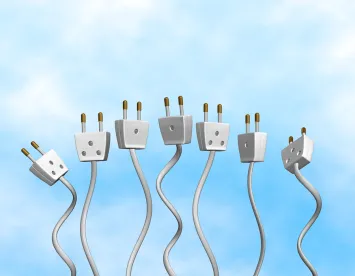FERC Issues Final Rule on Geomagnetic Disturbance Reliability Standard - September 30 - FERC issued a final rule approving Reliability Standard TPL-007-1, Transmission System Planned Performance for Geomagnetic Disturbance Events (GMDs). GMDs occur when charged particles from the sun cause changes in the earth's magnetic field. Reliability Standard TPL-007-1 requires registered entities to evaluate their vulnerability to GMDs. FERC also directed NERC to develop modifications to the Reliability Standard to modify the benchmark GMD event definition, require the collection of geomagnetically induced current (GIC) data, and include a one-year deadline for corrective action plans and two and four-year deadlines for mitigation actions involving non-hardware and hardware mitigation. The directed revisions must be submitted to FERC within 18 months of the November 29, 2016 effective date and the enforcement date for TPL-007-1 is July 1, 2017.
FERC NOPR Proposes Approval of NERC Reliability Standards - September 22 – FERC proposes to approve Reliability Standards BAL-005-1 (Balancing Authority Control), FAC-001-3 (Facility Interconnection Requirements), which clarifies and consolidates existing requirements related to frequency control. The proposed reliability standards support more accurate and comprehensive calculation of Reporting Area Control Error. Additionally, definitions of: Automatic Generation Control, Pseudo-tie, Balancing Authority, Reporting ACE, Actual Frequency, Actual Net Interchange, Scheduled Net Interchange, Interchange Meter Error, and Automatic Time Error Correction, are being revised. Finally, proposed for retirement are BAL-005-0.2b, FAC-001-2, and BAL-006-2. Comments are due on November 28.
FERC Approves Awareness and Monitoring Standards - September 22 - The two newly approved Reliability Standards, IRO-018-1 and TOP-010-1, require that applicable entities provide notification to operators of real-time system awareness and monitoring alarm failures. The Commission found the Standards adequately address the relevant directives in Order No. 693. FERC also approved the corresponding implementation plan, violation severity levels and violation risk facts, subject to certain exceptions.
NERC
NERC Publishes Industry Reference Guide - September 27 - NERC published the "Lessons Learned Quick Reference Guide" (Guide) as a resource for industry to identify and mitigate potential problems. The Guide was developed through a collaborative effort between NERC, the Regional Entities, and registered entities to provide an easy to manage tool for assuring continued reliability.
NERC Comments on CIP Notice of Inquiry - September 26 - NERC provided comments to FERC on the Notice of Inquiry for modifications to the Critical Infrastructure Protection (CIP) Reliability Standards concerning the cybersecurity of Control Centers and the potential impact that modifications may have on the Bulk-Power System. NERC notes that while modified CIP Reliability Standards could possibly reduce cybersecurity vulnerabilities, enforcing those standards may limit operational flexibility. NERC requests that FERC not direct modifications to the CIP Reliability Standards at this time, allowing NERC to further evaluate how modifications may impact operations.
3 New NERC Standards Become Effective – October 1 – The following NERC Reliability standards have an October 1st enforcement date:
NERC Submits Supplemental Clarification Information on Regional Entity 2017 Business Plans and Budgets - September 23 - NERC submitted a supplemental clarification filing to its August 23, 2016 filing regarding budgets and business plans of Regional Entities for 2017. Specifically, NERC clarifies the items in the proposed 2017 Business Plans and Budgets of the Northeast Power Coordinating Council, Inc. and ReliabilityFirst Corporation.
Congress
New Category of “Critical Infrastructure” Introduced in House - September 20 - In light of the recent cyberattacks on the Democratic Congressional Campaign Committee, lawmakers introduced legislation which would add voting to the list of 16 other federally defined categories of "critical infrastructure." Currently, there are 16 critical infrastructure sectors. If the legislation is passed, thousands of state and local systems would be designated critical infrastructure and therefore require the Department of Homeland Security to develop a comprehensive plan for countering online and physical threats to the integrity of the U.S. elections.





 />i
/>i
